Contents
Antihistamines are substances that inhibit the action of free histamine. When an allergen enters the body, histamine is released from the mast cells of the connective tissue that are part of the body’s immune system. It begins to interact with specific receptors and cause itching, swelling, rash and other allergic manifestations. Antihistamines are responsible for blocking these receptors. There are three generations of these drugs.
1st generation antihistamines

They appeared in 1936 and continue to be used. These drugs reversibly bind to H1 receptors, which explains the need for a large dosage and high frequency of administration.
Antihistamines of the 1st generation are characterized by the following pharmacological properties:
reduce muscle tone;
have a sedative, hypnotic and anticholinergic effect;
potentiate the effects of alcohol;
have a local anesthetic effect;
give a quick and strong, but short-term (4-8 hours) therapeutic effect;
long-term use reduces antihistamine activity, so every 2-3 weeks the funds are changed.
The bulk of 1st generation antihistamines are fat-soluble, can overcome the blood-brain barrier and bind to the H1 receptors of the brain, which explains the sedative effect of these drugs, which is enhanced after taking alcohol or psychotropic drugs. When taking medium therapeutic doses in children and high toxic doses in adults, psychomotor agitation may be observed. Due to the presence of a sedative effect, 1st generation antihistamines are not prescribed to persons whose activities require increased attention.
The anticholinergic properties of these drugs cause atropine-like reactions, such as tachycardia, dryness of the nasopharynx and mouth, urinary retention, constipation, visual impairment. These features can be beneficial in rhinitis, but they can increase airway obstruction caused by bronchial asthma (sputum viscosity increases), exacerbate prostate adenoma, glaucoma and other diseases. At the same time, these drugs have an antiemetic and anti-swaying effect, reduce the manifestation of parkinsonism.
A number of these antihistamines are included in combination products that are used for migraines, colds, motion sickness, or have a sedative or hypnotic effect.
An extensive list of side effects from taking these antihistamines makes them less likely to be used in the treatment of allergic diseases. Many developed countries have banned their implementation.
Dimedrol
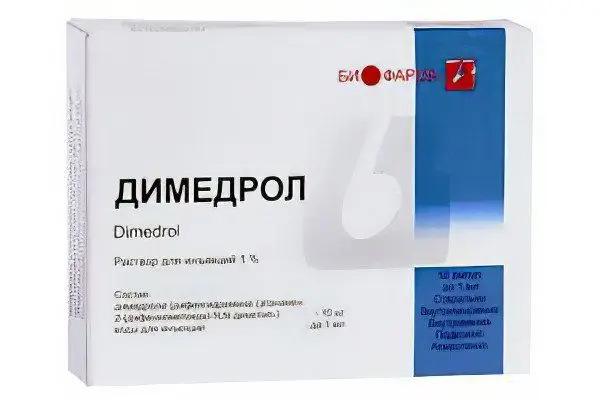
Diphenhydramine is prescribed for hay fever, urticaria, sea sickness, air sickness, vasomotor rhinitis, bronchial asthma, allergic reactions caused by the administration of medicinal substances (for example, antibiotics), in the treatment of peptic ulcer, dermatoses, etc.
Advantages: high antihistamine activity, reduced severity of allergic, pseudo-allergic reactions. Diphenhydramine has antiemetic and antitussive effects, has a local anesthetic effect, due to which it is an alternative to Novocaine and Lidocaine in case of their intolerance.
Cons: unpredictability of the consequences of taking the drug, its effects on the central nervous system. It can cause urinary retention and dry mucous membranes. Side effects include sedative and hypnotic effects.
Diazolin
Diazolin has the same indications for use as other antihistamines, but differs from them in the features of the effect.
Advantages: a mild sedative effect allows it to be used where it is undesirable to have a depressing effect on the central nervous system.
Cons: irritates the mucous membranes of the gastrointestinal tract, causes dizziness, impaired urination, drowsiness, slows down mental and motor reactions. There is information about the toxic effect of the drug on nerve cells.
Suprastin
Suprastin is prescribed for the treatment of seasonal and chronic allergic conjunctivitis, urticaria, atopic dermatitis, Quincke’s edema, itching of various etiologies, eczema. It is used in parenteral form for acute allergic conditions requiring emergency care.
Advantages: in the blood serum does not accumulate, therefore, even with prolonged use does not cause an overdose. Due to the high antihistamine activity, a rapid therapeutic effect is observed.
Cons: side effects – drowsiness, dizziness, inhibition of reactions, etc. – are present, although they are less pronounced. The therapeutic effect is short-term, in order to prolong it, Suprastin is combined with H1-blockers that do not have sedative properties.
Tavegil

Tavegil in the form of injections is used for angioedema, as well as anaphylactic shock, as a prophylactic and therapeutic agent for allergic and pseudo-allergic reactions.
Advantages: has a longer and stronger antihistamine effect than Diphenhydramine, and has a more moderate sedative effect.
Cons: can itself cause an allergic reaction, has some inhibitory effect.
Fenkarol
Phencarol is prescribed when addiction to other antihistamines appears.
Advantages: has a mild sedative properties, does not have a pronounced inhibitory effect on the central nervous system, is low toxic, blocks H1 receptors, and is able to reduce the content of histamine in tissues.
Cons: lower antihistamine activity in comparison with Diphenhydramine. Fenkarol is used with caution in the presence of diseases of the gastrointestinal tract, cardiovascular system and liver.
2st generation antihistamines
They have advantages over first generation drugs:
there is no sedative and anticholinergic effect, since these drugs do not cross the blood-brain barrier, only some individuals experience moderate drowsiness;
mental activity, physical activity do not suffer;
the effect of the drugs reaches 24 hours, so they are taken once a day;
they are not addictive, which allows them to be prescribed for a long time (3-12 months);
when you stop taking the drugs, the therapeutic effect lasts about a week;
drugs are not adsorbed with food in the gastrointestinal tract.
But antihistamines of the 2nd generation have a cardiotoxic effect of varying degrees, therefore, when they are taken, cardiac activity is monitored. They are contraindicated in elderly patients and patients suffering from disorders of the cardiovascular system.
The occurrence of cardiotoxic action is explained by the ability of 2nd generation antihistamines to block the potassium channels of the heart. The risk is increased when these drugs are combined with antifungal drugs, macrolides, antidepressants, grapefruit juice, and if the patient has severe liver dysfunction.
Claridol and Clarisens
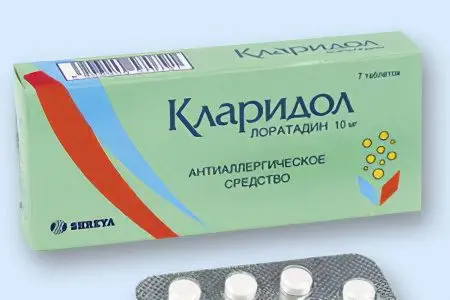
Claridol is used to treat seasonal as well as cyclic allergic rhinitis, urticaria, allergic conjunctivitis, Quincke’s edema and a number of other diseases of allergic origin. It copes with pseudo-allergic syndromes and allergies to insect bites. Included in the complex measures for the treatment of itchy dermatoses.
Advantages: Claridol has antipruritic, antiallergic, antiexudative action. The drug reduces capillary permeability, prevents the development of edema, relieves spasm of smooth muscles. It does not affect the central nervous system, has no anticholinergic and sedative effect.
Cons: occasionally after taking Claridol, patients complain of dry mouth, nausea and vomiting.
Chlorotadine
Clarotadine contains the active substance loratadine, which is a selective blocker of H1-histamine receptors, on which it has a direct effect, avoiding the undesirable effects inherent in other antihistamines. Indications for use are allergic conjunctivitis, acute chronic and idiopathic urticaria, rhinitis, pseudo-allergic reactions associated with the release of histamine, allergic insect bites, itchy dermatoses.
Advantages: the drug does not have a sedative effect, is not addictive, acts quickly and for a long time.
Cons: undesirable consequences of taking Clarodin include disorders of the nervous system: asthenia, anxiety, drowsiness, depression, amnesia, tremor, agitation in a child. Dermatitis may appear on the skin. Frequent and painful urination, constipation and diarrhea. Weight gain due to disruption of the endocrine system. The defeat of the respiratory system can be manifested by cough, bronchospasm, sinusitis and similar manifestations.
Broken
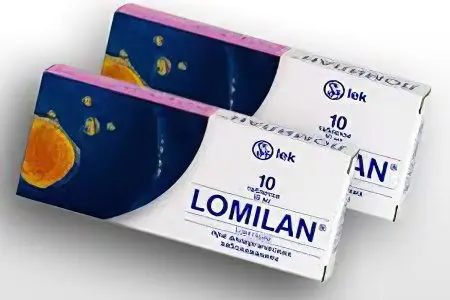
Lomilan is indicated for allergic rhinitis (rhinitis) of a seasonal and permanent nature, skin rashes of allergic origin, pseudo-allergies, reactions to insect bites, allergic inflammation of the mucous membrane of the eyeball.
Advantages: Lomilan is able to relieve itching, reduce the tone of smooth muscles and the production of exudate (a special fluid that appears during the inflammatory process), prevent tissue edema already half an hour after taking the drug. The greatest efficiency comes in 8-12 hours, then subsides. Lomilan is not addictive and does not adversely affect the activity of the nervous system.
Cons: adverse reactions are rare, manifested by headache, fatigue and drowsiness, inflammation of the gastric mucosa, nausea.
LauraGeksal
LoraGeksal is recommended for year-round and seasonal allergic rhinitis, conjunctivitis, itchy dermatoses, urticaria, Quincke’s edema, allergic insect bites and various pseudo-allergic reactions.
Advantages: the drug has neither anticholinergic nor central action, its intake does not affect the attention, psychomotor functions, working capacity and mental qualities of the patient.
Cons: LoraGeksal is usually well tolerated, but occasionally it causes fatigue, dry mouth, headache, tachycardia, dizziness, allergic reactions, cough, vomiting, gastritis, liver dysfunction.
Claritin
Claritin contains an active ingredient – loratadine, which blocks H1-histamine receptors and prevents the release of histamine, bradykinin and serotonin. Antihistamine effectiveness lasts a day, and therapeutic comes after 8-12 hours. Claritin is prescribed for the treatment of allergic rhinitis, allergic skin reactions, food allergies, and mild asthma.
Advantages: high efficiency in the treatment of allergic diseases, the drug is not addictive, drowsiness.
Cons: cases of side effects are rare, they are manifested by nausea, headache, gastritis, agitation, allergic reactions, drowsiness.
Rupafin
Rupafin has a unique active ingredient – rupatadine, which is distinguished by antihistamine activity and a selective effect on H1-histamine peripheral receptors. It is prescribed for chronic idiopathic urticaria and allergic rhinitis.
Advantages: Rupafin effectively copes with the symptoms of the above allergic diseases and does not affect the functioning of the central nervous system.
Cons: undesirable consequences of taking the drug – asthenia, dizziness, fatigue, headache, drowsiness, dry mouth. It can affect the respiratory, nervous, musculoskeletal, and digestive systems, as well as metabolism and skin.
Zirtek
Zirtek – competitive antagonist of the hydroxyzine metabolite, histamine. The drug facilitates the course and sometimes prevents the development of allergic reactions. Zyrtec limits the release of mediators, reduces the migration of eosinophils, basophils, neutrophils. The drug is used for allergic rhinitis, bronchial asthma, urticaria, conjunctivitis, dermatitis, fever, skin itching, angioedema.
Advantages: effectively prevents the occurrence of edema, reduces capillary permeability, relieves spasm of smooth muscles. Zyrtec does not have anticholinergic and antiserotonin effects.
Cons: improper use of the drug can lead to dizziness, migraine, drowsiness, allergic reactions.
Cut out
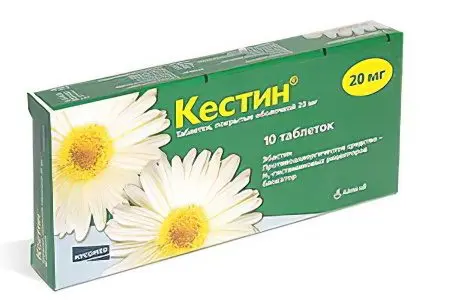
Kestin blocks histamine receptors that increase vascular permeability, causing muscle spasms, leading to an allergic reaction. It is used to treat allergic conjunctivitis, rhinitis and chronic idiopathic urticaria.
Advantages: the drug acts an hour after application, the therapeutic effect persists for 2 days. A five-day intake of Kestin allows you to maintain an antihistamine effect for about 6 days. Sedative effects are practically non-existent.
Cons: the use of Kestin can cause insomnia, abdominal pain, nausea, drowsiness, asthenia, headache, sinusitis, dry mouth.
New antihistamines, 3rd generation
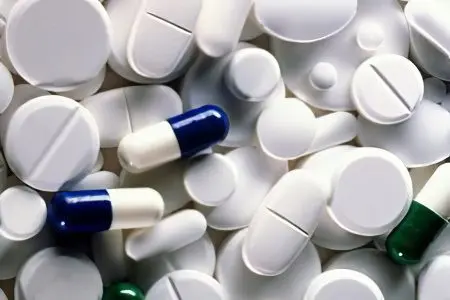
These substances are prodrugs, which means that when they enter the body, they are converted from their original form into pharmacologically active metabolites.
All 3rd generation antihistamines do not have a cardiotoxic and sedative effect, so they can be used by people whose activities are associated with a high concentration of attention.
These drugs block H1 receptors, and also have an additional effect on allergic manifestations. They have high selectivity, do not overcome the blood-brain barrier, so they are not characterized by negative consequences from the central nervous system, there is no side effect on the heart.
The presence of additional effects contributes to the use of 3rd generation antihistamines in the long-term treatment of most allergic manifestations.
Gismanal
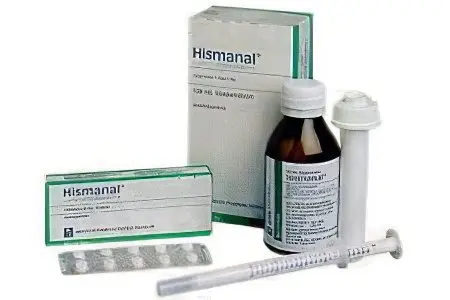
Hismanal is prescribed as a therapeutic and prophylactic agent for hay fever, allergic skin reactions, including urticaria, and allergic rhinitis. The effect of the drug develops within 24 hours and reaches a maximum after 9-12 days. Its duration depends on the previous therapy.
Advantages: the drug has practically no sedative effect, does not enhance the effect of taking sleeping pills or alcohol. It also does not affect the ability to drive a car or mental activity.
Cons: Hismanal can cause increased appetite, dry mucous membranes, tachycardia, drowsiness, arrhythmia, QT prolongation, palpitations, and collapse.
Trexil

Trexil – it is a fast-acting selectively active H1 receptor antagonist, a derivative of butyrophenone, which differs in chemical structure from analogs. It is used in allergic rhinitis to relieve its symptoms, allergic dermatological manifestations (dermographism, contact dermatitis, urticaria, atonic eczema,), asthma, atonic and provoked by exercise, as well as in connection with acute allergic reactions to various irritants.
Advantages: lack of sedative and anticholinergic effect, influence on psychomotor activity and well-being of a person. The drug is safe to use in patients with glaucoma and prostate disorders.
Cons: when the recommended dosage was exceeded, a weak manifestation of a sedative effect was observed, as well as reactions from the gastrointestinal tract, skin and respiratory tract.
Telfast

Telfast – a highly effective antihistamine drug, which is a metabolite of terfenadine, therefore, has a great similarity with histamine H1 receptors. Telfast binds to them and blocks them, preventing their biological manifestations as allergic symptoms. Mast cell membranes are stabilized and the release of histamine from them is reduced. Indications for use are angioedema, urticaria, hay fever.
Advantages: does not show sedative properties, does not affect the speed of reactions and concentration of attention, the work of the heart, is not addictive, highly effective against the symptoms and causes of allergic diseases.
Cons: rare consequences of taking the drug are headache, nausea, dizziness, very rarely there is shortness of breath, anaphylactic reaction, skin flushing.
Fexadine
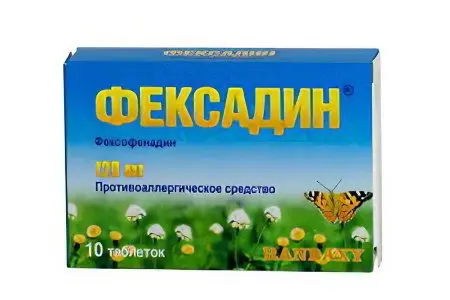
The drug is used to treat seasonal allergic rhinitis with the following manifestations of hay fever: skin itching, sneezing, rhinitis, redness of the mucous membrane of the eyes, as well as for the treatment of chronic idiopathic urticaria and its symptoms: skin itching, redness.
Advantages – when taking the drug, side effects characteristic of antihistamines do not appear: visual impairment, constipation, dryness of the oral mucosa, weight gain, a negative effect on the functioning of the heart muscle. The drug can be purchased at a pharmacy without a prescription, no dose adjustment is required for the elderly, patients and renal and hepatic insufficiency. The drug acts quickly, maintaining its effect during the day. The price of the drug is not too high, it is available to many people suffering from allergies.
Disadvantages – after some time, addiction to the action of the drug is possible, it has side effects: dyspepsia, dysmenorrhea, tachycardia, headache and dizziness, anaphylactic reactions, taste perversion. Dependence on the drug may form.
Fexofast

The drug is prescribed for the appearance of seasonal allergic rhinitis, as well as for chronic urticaria.
Advantages – the drug is rapidly absorbed, reaching the desired one within an hour after ingestion, this action continues throughout the day. Its reception does not require restrictions for people operating complex mechanisms, driving vehicles, and does not cause a sedative effect. Fexofast is available without a prescription, has an affordable price, and is highly effective.
Disadvantages – for some patients, the drug brings only temporary relief, without bringing a complete recovery from the manifestations of allergies. It has side effects: swelling, increased drowsiness, nervousness, insomnia, headache, weakness, increased allergy symptoms in the form of itching, skin rash.
Levocetirizine-Teva
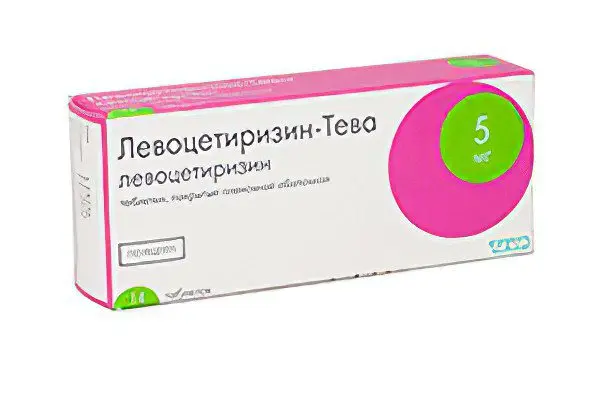
The drug is prescribed for the symptomatic treatment of hay fever (hay fever), urticaria, allergic rhinitis and allergic conjunctivitis with itching, lacrimation, conjunctival hyperemia, dermatosis with rash and rashes, angioedema.
Advantages – Levocitirizine-Teva quickly shows its effectiveness (after 12-60 minutes) and during the day it prevents the appearance and weakens the course of allergic reactions. The drug is rapidly absorbed, showing 100% bioavailability. It can be used for long-term treatment and for emergency help with seasonal exacerbations of allergies. Available for the treatment of children from 6 years.
Disadvantages – has such side effects as drowsiness, irritability, nausea, headache, weight gain, tachycardia, abdominal pain, Quincke’s edema, migraine. The price of the medicine is quite high.
Xyzal
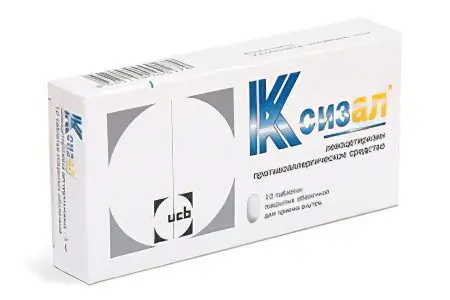
The drug is used for the symptomatic treatment of such manifestations of hay fever and urticaria as skin itching, sneezing, inflammation of the conjunctiva, rhinorrhea, Quincke’s edema, allergic dermatoses.
Advantages – Ksizal has a pronounced anti-allergic orientation, being a very effective remedy. It prevents the onset of allergy symptoms, facilitates their course, and has no sedative effect. The drug acts very quickly, maintaining its effect for a day from the moment of admission. Ksizal can be used to treat children from 2 years of age, it is available in two dosage forms (tablets, drops) that are acceptable for use in pediatrics. It eliminates nasal congestion, the symptoms of chronic allergies are quickly stopped, it does not have a toxic effect on the heart and central nervous system.
Disadvantages – the agent may exhibit the following side effects: dry mouth, fatigue, abdominal pain, pruritus, hallucinations, shortness of breath, hepatitis, convulsions, muscle pain.
Erius

The drug is indicated for the treatment of seasonal hay fever, allergic rhinitis, chronic idiopathic urticaria with symptoms such as lacrimation, cough, itching, swelling of the nasopharyngeal mucosa.
Advantages – Erius acts exceptionally quickly on allergy symptoms, can be used to treat children from one year old, as it has a high degree of safety. Well tolerated by both adults and children, it is available in several dosage forms (tablets, syrup), which is very convenient for use in pediatrics. It can be taken for a long time period (up to a year) without causing addiction (resistance to it). Reliably stops the manifestations of the initial phase of the allergic response. After a course of treatment, the effect of it persists for 10-14 days. Overdose symptoms were not observed even with a fivefold increase in the dose of Erius.
Disadvantages – side effects may occur (nausea and vomiting, headache, tachycardia, local allergic symptoms, diarrhea, hyperthermia). Children usually have insomnia, headache, fever.
Desal
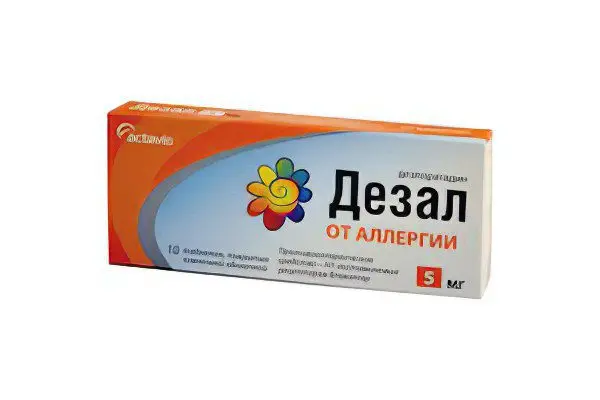
The drug is intended for the treatment of allergic manifestations such as allergic rhinitis, and urticaria, marked by itching and skin rashes. The drug stops such symptoms of allergic rhinitis as sneezing, itching in the nose and in the sky, watery eyes.
Advantages – Desal prevents the appearance of edema, muscle spasm, reduces capillary permeability. The effect of taking the drug can be seen after 20 minutes, it persists for a day. A single dose of the medicine is very convenient, two forms of its release are syrup and tablets, the intake of which does not depend on food. Since Desal is taken to treat children from 12 months of age, the syrup form of the drug is in demand. The drug is so safe that even a 9-fold excess of the dose does not lead to negative symptoms.
Disadvantages – occasionally, symptoms of side effects such as increased fatigue, headache, dryness of the oral mucosa may occur. Additionally, side effects such as insomnia, tachycardia, the appearance of hallucinations, diarrhea, and hyperactivity are manifested. Allergic manifestations of side effects are possible: itching, urticaria, angioedema.
4th generation antihistamines – do they exist?
All statements by advertisers positioning drug brands as “fourth-generation antihistamines” are nothing more than a publicity stunt. This pharmacological group does not exist, although marketers include not only newly created drugs, but also second-generation drugs.
The official classification indicates only two groups of antihistamines – these are first and second generation drugs. The third group of pharmacologically active metabolites is positioned in pharmaceuticals as “H1 third generation histamine blockers.
Antihistamines for children

For the treatment of allergic manifestations in children, antihistamines of all three generations are used.
Antihistamines of the 1st generation are distinguished by the fact that they quickly show their healing properties and are excreted from the body. They are in demand for the treatment of acute manifestations of allergic reactions. They are prescribed in short courses. The most effective of this group is Tavegil, Suprastin, Diazolin, Fenkarol.
A significant percentage of side effects leads to a reduction in the use of these drugs for childhood allergies.
Antihistamines of the 2nd generation do not cause sedation, act for a longer time and are usually used once a day. Few side effects. Among the drugs in this group, Ketotifen, Fenistil, Cetrin are used to treat manifestations of childhood allergies.
3rd generation antihistamines for children include Gismanal, Terfen and others. They are used in chronic allergic processes, since they are able to stay in the body for a long time. There are no side effects.
Erius can be attributed to newer drugs.
Negative consequences:
1st generation: headache, constipation, tachycardia, drowsiness, dry mouth, blurred vision, urinary retention and lack of appetite;
2nd generation: negative effect on the heart and liver;
3rd generation: do not have, recommended for use from 3 years.
For children, antihistamines are produced in the form of ointments (allergic reactions on the skin), drops, syrups and tablets for oral administration.
Antihistamines during pregnancy

In the first trimester of pregnancy, it is forbidden to take antihistamines. In the second, they are prescribed only in extreme cases, since none of these remedies is absolutely safe.
Natural antihistamines, which include vitamins C, B12, pantothenic, oleic and nicotinic acids, zinc, fish oil, can help get rid of some allergic symptoms.
The safest antihistamines are Claritin, Zirtek, Telfast, Avil, but their use must be agreed with the doctor without fail.
4 Best Natural Antihistamines
In some cases, you can resort to the help of the following funds, which can suppress the production of histamine in the body.
Nettle. Nettle has antihistamine properties. Freeze-dried nettle powder has been proven to help relieve allergy symptoms. 69 people took part in the experiment using this substance. Of these, 58% of patients noted a significant improvement in well-being. The positive effect was achieved thanks to a daily intake of 300 mg of nettle. [1].
Quercetin. Quercetin is an antioxidant known for its anti-inflammatory properties. It is found in some foods, such as onions and apples. Scientists are interested in the ability of quercetin to reduce the severity of an allergic reaction [2]. The experiment was carried out on rats. Based on its results, it was concluded that quercetin can reduce the intensity of allergic rhinitis and the inflammatory process in the respiratory system. [3]. People with allergies can either purchase quercetin in supplements or just eat foods that are rich in this antioxidant.
Bromelain. Bromelain is an enzyme found in high amounts in pineapples. There is evidence that it helps to reduce the intensity of allergy symptoms. To have a positive effect, it is recommended to take 400-500 mg of this substance 3 times a day. [1]. Alternatively, you can simply enrich your diet with pineapples, which hold the record for the content of this substance.
Vitamin C. Vitamin C is found in various foods. This antioxidant has properties to suppress the symptoms of an allergic reaction. Vitamin C is non-toxic, its intake in moderate dosages does not harm the human body. Therefore, it can be safely used as an antihistamine. The recommended dose of vitamin C for allergy sufferers is 2 g [1].
Food to help fight allergies
To cope with allergies, it is not necessary to empty the pharmacy shelves. Sometimes it is enough to minimize contact with the allergen and enrich your menu with products that have antihistamine properties. A proper diet, combined with physical activity, will help the immune system resist attacks from the external environment.
As for antioxidants in the form of supplements, they should be taken only after consultation with a specialist. The best way to get these substances is from food. So they will be absorbed by 100%.









